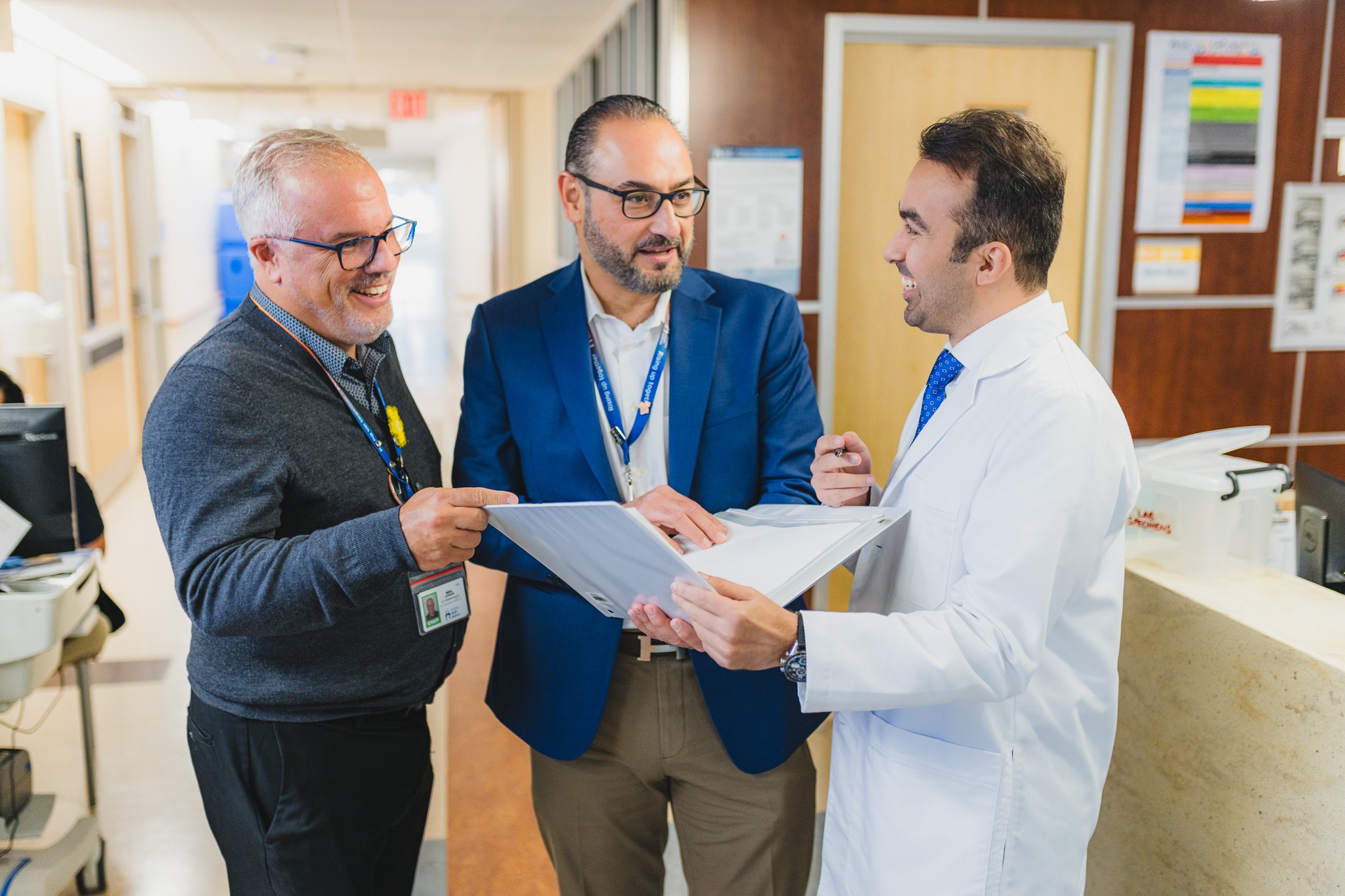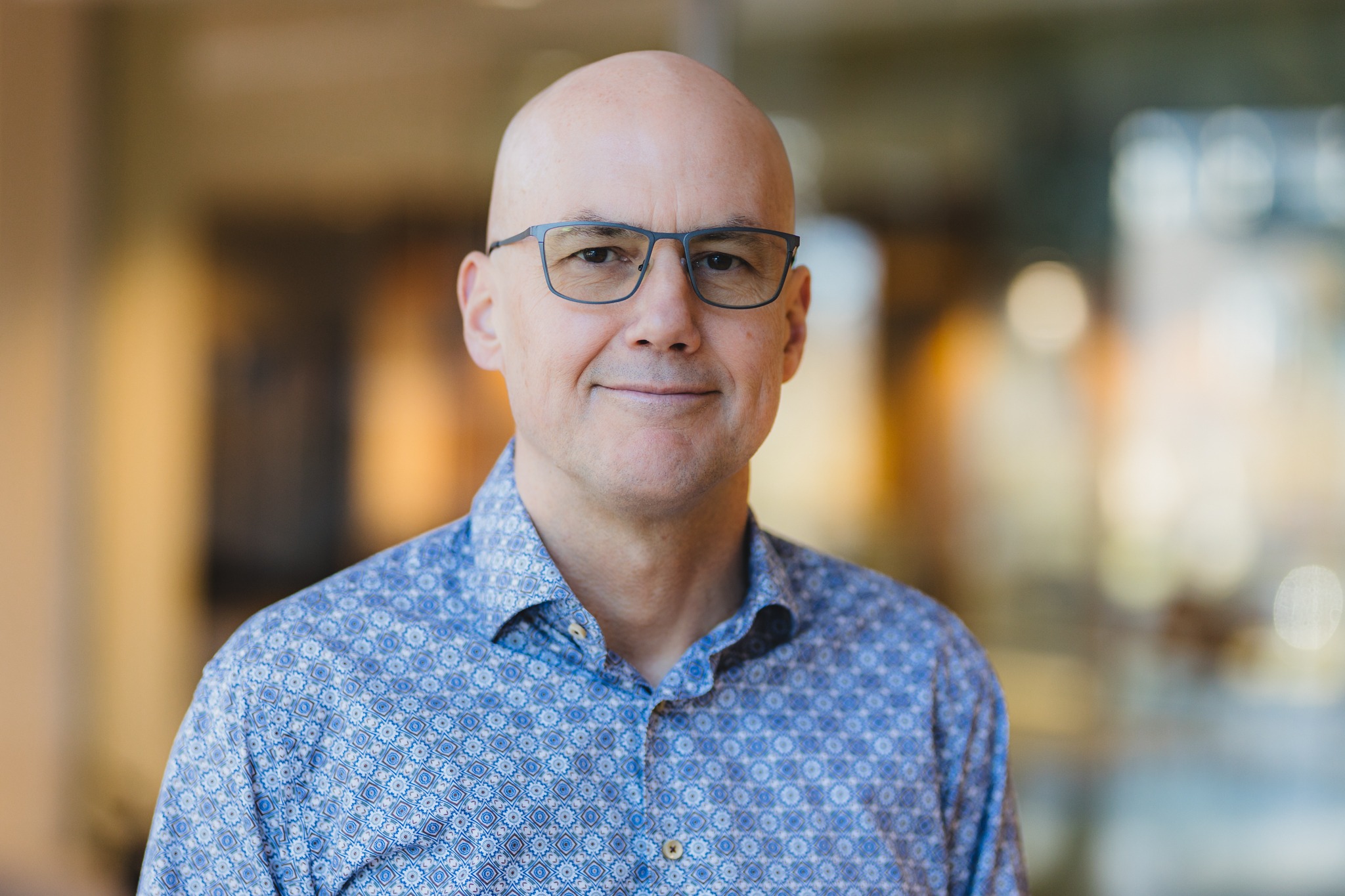
HHS surgeon’s award-winning technology teaches surgical skills, worldwide
As a surgical team at Hamilton Health Sciences (HHS) Hamilton General Hospital (HGH) performed life-altering reconstructive surgery on a gunshot patient, doctors nearly 8,000 km away in war-torn Ukraine observed and learned from the team’s advanced surgical techniques in real time, thanks to leading-edge livestreaming technology developed by HHS neurosurgeon Dr. Aleksa Cenic, co-founder of Vivo Surgery.

Dr. Aleksa Cenic, HHS neurosurgeon and co-founder of Vivo Surgery
HHS is a leading academic health science institution, and Cenic came up with the concept for Vivo Surgery during the pandemic to give McMaster University medical students opportunities to view HHS surgeries in real time because they weren’t permitted in operating rooms to observe due to COVID-19.
Since launching four years ago, Vivo Surgery has expanded worldwide to teach medical students, residents, fellows and physicians in 30 remote locations including in the United States, Ukraine, the Caribbean, Singapore, Oman, Poland, Switzerland and England, giving learners opportunities to view leading-edge livestreamed operations at HHS.
“Exposure to different operating processes and techniques was very beneficial to our surgeons, as they are faced with ever increasing complexities of battlefield trauma.” — Dr. Vadym Lutsyshyn, Ukrainian physician
The cloud-based, portable platform offers a live, interactive, high-definition, multi-view video display from HHS operating rooms, delivering a secure livestream experience with no lag time. HHS surgeons wear a head camera to provide a close-up view of surgical techniques, explaining the surgery while they work and answering learners’ questions in real time.
Learners also see operating room technology in action, as the view switches from the surgeon’s headcam to visualization devices such as a surgical microscope, laparoscope or endoscope.
Young innovators such as McMaster biomedical engineering students have also started accessing Vivo Surgery for inspiration in developing new operating-room technology.
Award-winning innovation
Cenic and Vivo Surgery received a 2023 HHS DRIVE Spark funding grant of $50,000 to support and promote innovation and commercialization efforts within the HHS hospital community. They also have an opportunity to apply for a $50k renewal. Funding is being used to support learners focused on developing technology.

Dr. Marc Jeschke, HHS vice president of research and chief scientific officer
“In just four years, Vivo Surgery has evolved from a concept aimed at helping our local medical students during the pandemic to a platform that’s assisting all level of learners, including physicians and innovators locally, nationally and internationally,” says Dr. Marc Jeschke, vice president of research and chief scientific officer for HHS. “We were pleased to recognize this innovative work with a well-deserved DRIVE Spark funding grant.”
Nine HHS surgeons specializing neurosurgery, orthopedic surgery, vascular surgery and plastic surgery have livestreamed surgeries with Vivo Surgery. The technology is available at all HHS hospital sites where surgery is performed, and has so far been used at HGH, HHS Juravinski Hospital and Cancer Centre, and HHS West Lincoln Memorial Hospital.
HHS is currently the only North American hospital using Vivo Surgery, though it was recently implemented at the University of Basel Hospital (Universitatsspital Basel) in Switzerland.
Training warzone doctors
Nineteen Ukrainian physicians including Dr. Vadym Lutsyshyn observed the 15-hour operation on the gunshot patient. “Exposure to different operating processes and techniques was very beneficial to our surgeons, as they are faced with ever increasing complexities of battlefield trauma,” Lutsyshyn shares on Vivo Surgery’s website.
HHS plastic surgeons Dr. Chris Coroneos and Dr. Matthew Choi performed that surgery, with Coroneos wearing the headcam. It was his first time using the technology. “I narrated what I was doing as I operated, and fielded questions when I wasn’t doing direct work on the patient,” he said, adding, “There were some language challenges, but the Ukrainian physicians were very engaged.”
Coroneos considers Vivo Surgery to be a powerful educational tool. “I think it’s remarkably effective. Video, whether live or recorded, is the best tool short of being in the operating room to see an actual surgery.”
Student’s concern inspires Vivo Surgery
Coroneos, Choi and Cenic are also medical advisors for McMaster University medical students, and the idea for Vivo Surgery was inspired by a concern raised by one of Cenic’s students back in 2020 because she couldn’t attend live surgeries due to the pandemic.
“She told me that she was losing out on her education,” recalls Cenic. “She was interested in studying surgery, but couldn’t get into an operating room to experience, first hand, what it’s like to be in that environment.”
Cenic was brainstorming ways to address the student’s concerns, when a solution presented itself in an unlikely place — his daughter’s dance studio.
Another dance dad, the father of one of his daughter’s friends, was a video streaming engineer. “I knew what he did for a living, so I approached him and asked if there was any way I could live stream my surgeries,” says Cenic. “He answered yes.”

Phillip Mohabir, Vivo Surgery CEO.
The two men went on to launch Vivo Surgery, along with Cenic’s cousin, an engineer specializing in audio visual technology. They brought in Phillip Mohabir as the fourth co-founder and CEO. Mohabir holds an MBA from the Rotman School of Management at the University of Toronto and worked as a global expansion leader for IMAX before joining VIVO Surgery’s leadership team.
Patients are a key part of Vivo Surgery’s success, and provide signed consent to have their surgeries shared, says Mohabir.
The technology landed international attention when Mohabir arranged for a video ad on YouTube targeting medical students, and received over 1,000 responses from around the world.
Early days
The very first surgery to be livestreamed using Vivo Surgery was viewed by six McMaster medical students including the one who had expressed concerns. It was a lumbar laminectomy by Cenic to help relieve a patient’s back and leg pain. Cenic’s headcam gave students a close-up view.
“Most surgeons wear a headlight when they operate, so also wearing a small, very light camera feels normal to us,” says Cenic, adding that the experience was very well received by the students.
Front-row seat
When medical students attend a surgery in person, they’re sharing space with surgeons, a fellow, a resident doctor, nurses and other members of the team. “It can be difficult, in such an environment, for students to get a good view of the procedure,” says Cenic. “They’re literally trying to look over people’s shoulders to see what’s going on.”

Surgeons using this technology can take time after operations, or when they’re not not doing direct work on patients, to answer viewers’ questions.
And while an operating room can only accommodate one or two medical students, Vivo Surgery can include up to 50 learners at once from multiple locations worldwide. For example a surgery performed by HHS orthopedic surgeon Dr. Bill Ristevski drew close to 40 learners from 12 countries.
Promoting diversity
This technology also promotes diversity, says Mohabir.
“There’s an underlying push in medicine for diversity among surgeons. The solution has traditionally been to match medical students from diverse backgrounds with surgeons who look like them. Unfortunately, it’s just not scalable in the real world, but it’s something we’re able to do with Vivo Surgery.”
Seeing technology in action
At the beginning of an operation, as the patient is being given anesthetic, the surgeon reviews images, such as an MRI, and explains what’s about to take place.

A Vivo Surgery can include up to 50 learners at once from multiple locations worldwide.
Learners see operating room technology in action, as the view switches from the surgeon’s head cam to surgical tools. For example, for a microdiscectomy surgery performed to relieve pressure on a spinal nerve root, the view will automatically switch from the headcam to a microscope view. For a tumor surgery, it switches from the headcam to x-rays and a complex imaging guidance system.
“So they’re not only watching from the surgeon’s point of view,” says Cenic. “They’re are also seeing how we work in partnership with technology.”
“I had always been interested in surgery so it really excited me to have the opportunity to watch a surgery remotely.” — Dr. Amna Ismaili, former medical student
For students who are undecided about surgery for a career path, the experience can be a game changer. “When a person first enters medical school, they often don’t know if they’re a surgical person or a medical person,” says Cenic. “This experience can help them decide.”
A student’s perspective
Dr. Amna Ismaili was in her first year of medical school three years ago when she viewed a Vivo Surgery from the comfort of her home. While medical students were allowed back into operating rooms by then, attending in-person was reserved for senior students.
“As a first-year student, I was offered the opportunity to view HHS surgeries through Vivo Surgery,” says Ismaili, who recently graduated from medical school and is starting her residency at University of British Columbia in vascular surgery this summer. “I had always been interested in surgery so it really excited me to have the opportunity to watch a surgery remotely.”
The view was excellent, says Ismaili, who especially appreciated the surgeon explaining what was happening in real time, and fielding questions.
While Vivo Surgery will never replace observing in-person, it’s an excellent option for medical students at any stage of their studies, says Cenic.
HHS DRIVE Spark funding
Learners include young innovators, such as McMaster biomedical engineering students exploring new health-care technologies through the university’s Innovators in Scrubs program. When number of students in that program doubled last year, there were challenges finding enough operating room space for in-person observation so students could see surgical equipment in action.
Much of Cenic and Vivo’s DRIVE Spark funding went towards commercializing the technology so it could be delivered to these students, with additional hours of observation time.
DRIVE — which stands for Dare, Research, Innovate, VenturE – cultivates the development of HHS’ research and innovation into medical technologies and solutions with the goal of transforming innovative ideas into real commercial solutions that could improve patient outcomes and advance health care. The inaugural competition was held in 2023 and two Spark winners are chosen annually.



